Case Scenario: Clinical Assessment and Professional Practice
VerifiedAdded on 2023/01/11
|7
|2316
|94
Case Study
AI Summary
This assignment presents a detailed case study focusing on professional practice in a healthcare setting. The student analyzes various clinical scenarios, including a patient experiencing a seizure and another with hypoglycemia, to demonstrate their understanding of clinical assessment, prioritization, and intervention strategies. The case study explores the importance of immediate actions, such as providing first aid for seizures and managing low blood glucose levels, along with the rationale behind these actions. It also addresses the prioritization of patient needs in multiple-patient scenarios, conflict resolution, and adherence to professional standards of conduct and medical policies. The student demonstrates the application of critical thinking in making informed decisions, providing optimal care, and ensuring patient safety, including the use of medication and other treatment protocols. The assignment highlights the importance of professional behavior, communication, and collaboration in providing effective patient care and achieving positive outcomes.
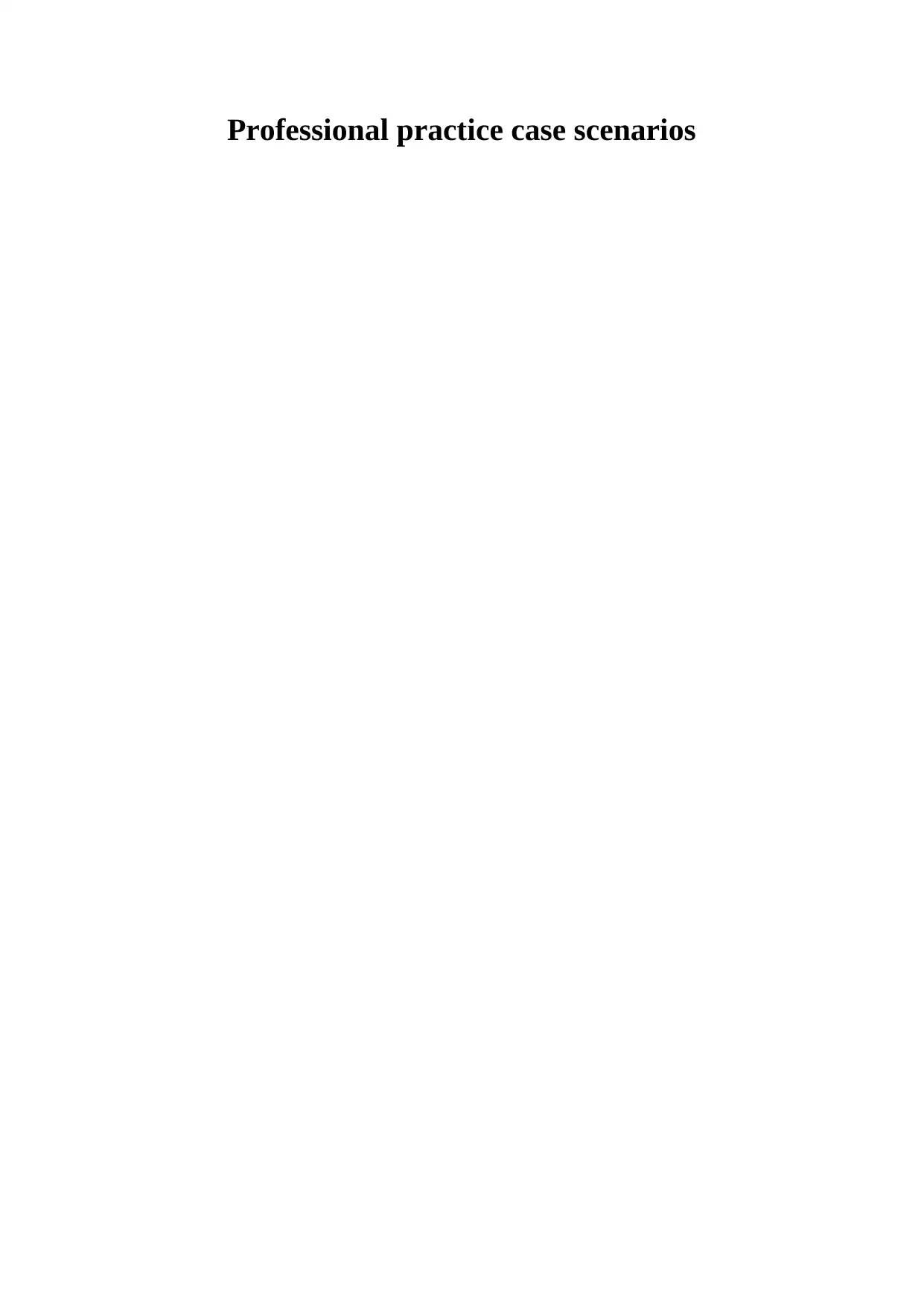
Professional practice case scenarios
Paraphrase This Document
Need a fresh take? Get an instant paraphrase of this document with our AI Paraphraser
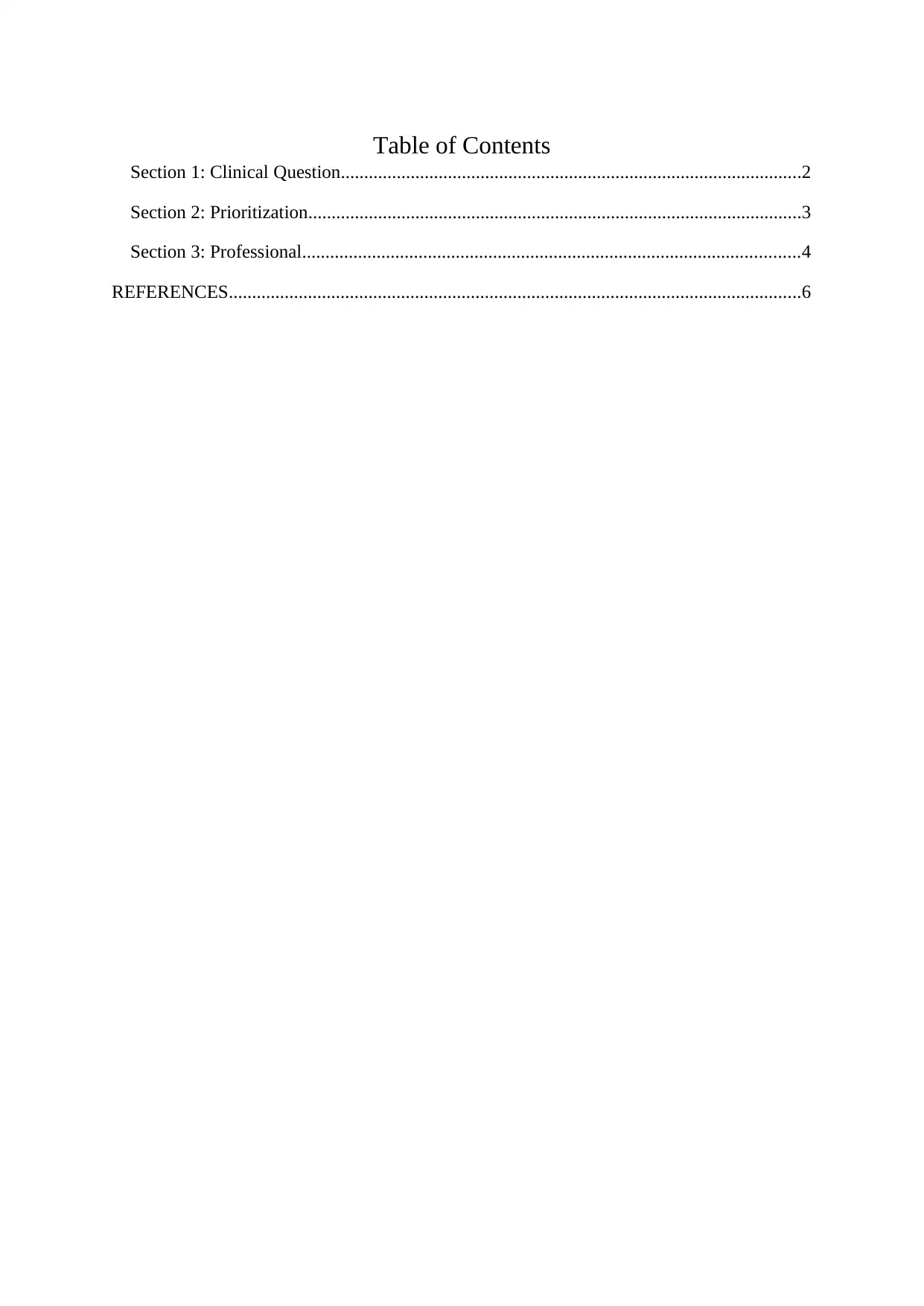
Table of Contents
Section 1: Clinical Question...................................................................................................2
Section 2: Prioritization..........................................................................................................3
Section 3: Professional...........................................................................................................4
REFERENCES...........................................................................................................................6
Section 1: Clinical Question...................................................................................................2
Section 2: Prioritization..........................................................................................................3
Section 3: Professional...........................................................................................................4
REFERENCES...........................................................................................................................6
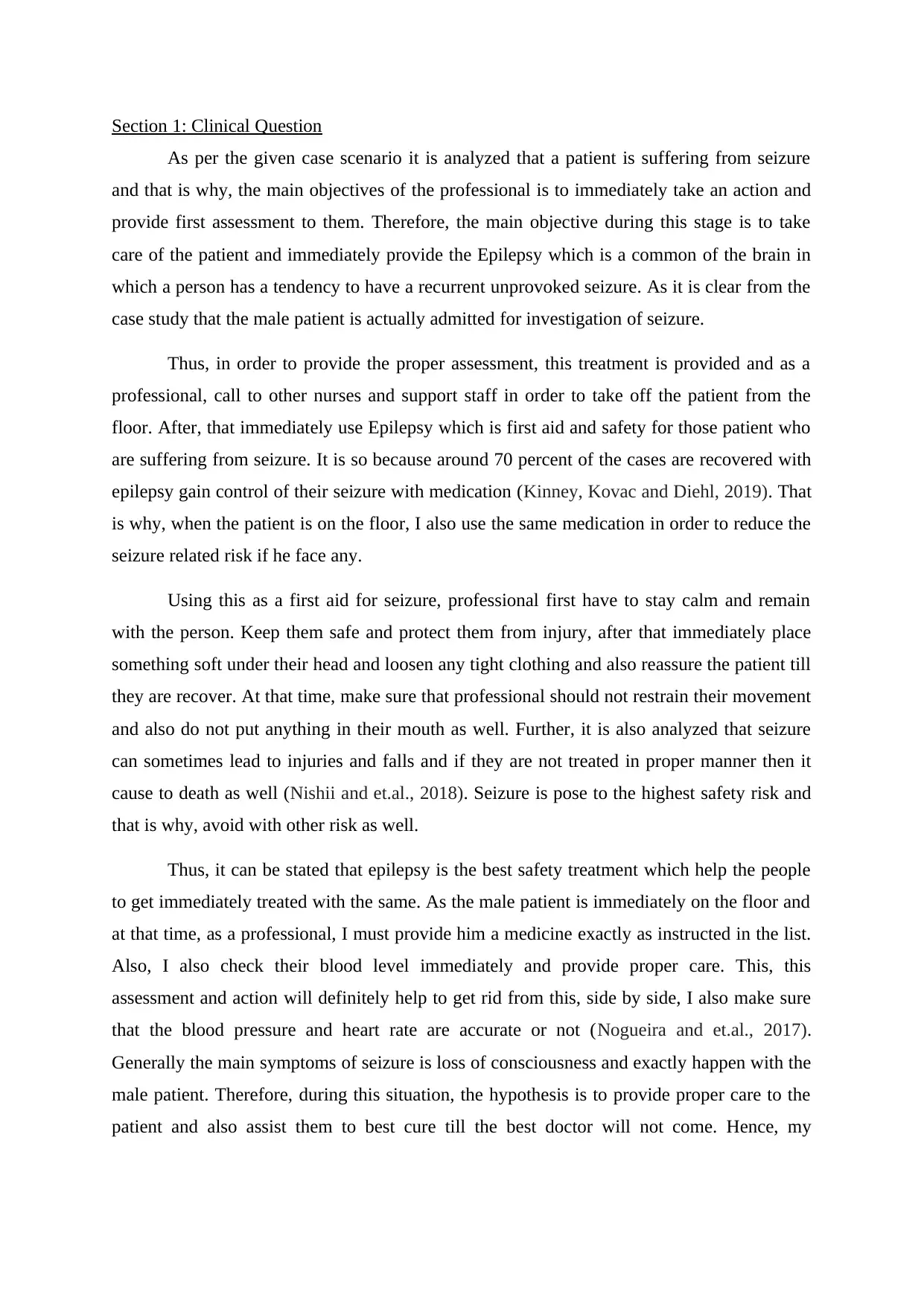
Section 1: Clinical Question
As per the given case scenario it is analyzed that a patient is suffering from seizure
and that is why, the main objectives of the professional is to immediately take an action and
provide first assessment to them. Therefore, the main objective during this stage is to take
care of the patient and immediately provide the Epilepsy which is a common of the brain in
which a person has a tendency to have a recurrent unprovoked seizure. As it is clear from the
case study that the male patient is actually admitted for investigation of seizure.
Thus, in order to provide the proper assessment, this treatment is provided and as a
professional, call to other nurses and support staff in order to take off the patient from the
floor. After, that immediately use Epilepsy which is first aid and safety for those patient who
are suffering from seizure. It is so because around 70 percent of the cases are recovered with
epilepsy gain control of their seizure with medication (Kinney, Kovac and Diehl, 2019). That
is why, when the patient is on the floor, I also use the same medication in order to reduce the
seizure related risk if he face any.
Using this as a first aid for seizure, professional first have to stay calm and remain
with the person. Keep them safe and protect them from injury, after that immediately place
something soft under their head and loosen any tight clothing and also reassure the patient till
they are recover. At that time, make sure that professional should not restrain their movement
and also do not put anything in their mouth as well. Further, it is also analyzed that seizure
can sometimes lead to injuries and falls and if they are not treated in proper manner then it
cause to death as well (Nishii and et.al., 2018). Seizure is pose to the highest safety risk and
that is why, avoid with other risk as well.
Thus, it can be stated that epilepsy is the best safety treatment which help the people
to get immediately treated with the same. As the male patient is immediately on the floor and
at that time, as a professional, I must provide him a medicine exactly as instructed in the list.
Also, I also check their blood level immediately and provide proper care. This, this
assessment and action will definitely help to get rid from this, side by side, I also make sure
that the blood pressure and heart rate are accurate or not (Nogueira and et.al., 2017).
Generally the main symptoms of seizure is loss of consciousness and exactly happen with the
male patient. Therefore, during this situation, the hypothesis is to provide proper care to the
patient and also assist them to best cure till the best doctor will not come. Hence, my
As per the given case scenario it is analyzed that a patient is suffering from seizure
and that is why, the main objectives of the professional is to immediately take an action and
provide first assessment to them. Therefore, the main objective during this stage is to take
care of the patient and immediately provide the Epilepsy which is a common of the brain in
which a person has a tendency to have a recurrent unprovoked seizure. As it is clear from the
case study that the male patient is actually admitted for investigation of seizure.
Thus, in order to provide the proper assessment, this treatment is provided and as a
professional, call to other nurses and support staff in order to take off the patient from the
floor. After, that immediately use Epilepsy which is first aid and safety for those patient who
are suffering from seizure. It is so because around 70 percent of the cases are recovered with
epilepsy gain control of their seizure with medication (Kinney, Kovac and Diehl, 2019). That
is why, when the patient is on the floor, I also use the same medication in order to reduce the
seizure related risk if he face any.
Using this as a first aid for seizure, professional first have to stay calm and remain
with the person. Keep them safe and protect them from injury, after that immediately place
something soft under their head and loosen any tight clothing and also reassure the patient till
they are recover. At that time, make sure that professional should not restrain their movement
and also do not put anything in their mouth as well. Further, it is also analyzed that seizure
can sometimes lead to injuries and falls and if they are not treated in proper manner then it
cause to death as well (Nishii and et.al., 2018). Seizure is pose to the highest safety risk and
that is why, avoid with other risk as well.
Thus, it can be stated that epilepsy is the best safety treatment which help the people
to get immediately treated with the same. As the male patient is immediately on the floor and
at that time, as a professional, I must provide him a medicine exactly as instructed in the list.
Also, I also check their blood level immediately and provide proper care. This, this
assessment and action will definitely help to get rid from this, side by side, I also make sure
that the blood pressure and heart rate are accurate or not (Nogueira and et.al., 2017).
Generally the main symptoms of seizure is loss of consciousness and exactly happen with the
male patient. Therefore, during this situation, the hypothesis is to provide proper care to the
patient and also assist them to best cure till the best doctor will not come. Hence, my
⊘ This is a preview!⊘
Do you want full access?
Subscribe today to unlock all pages.

Trusted by 1+ million students worldwide
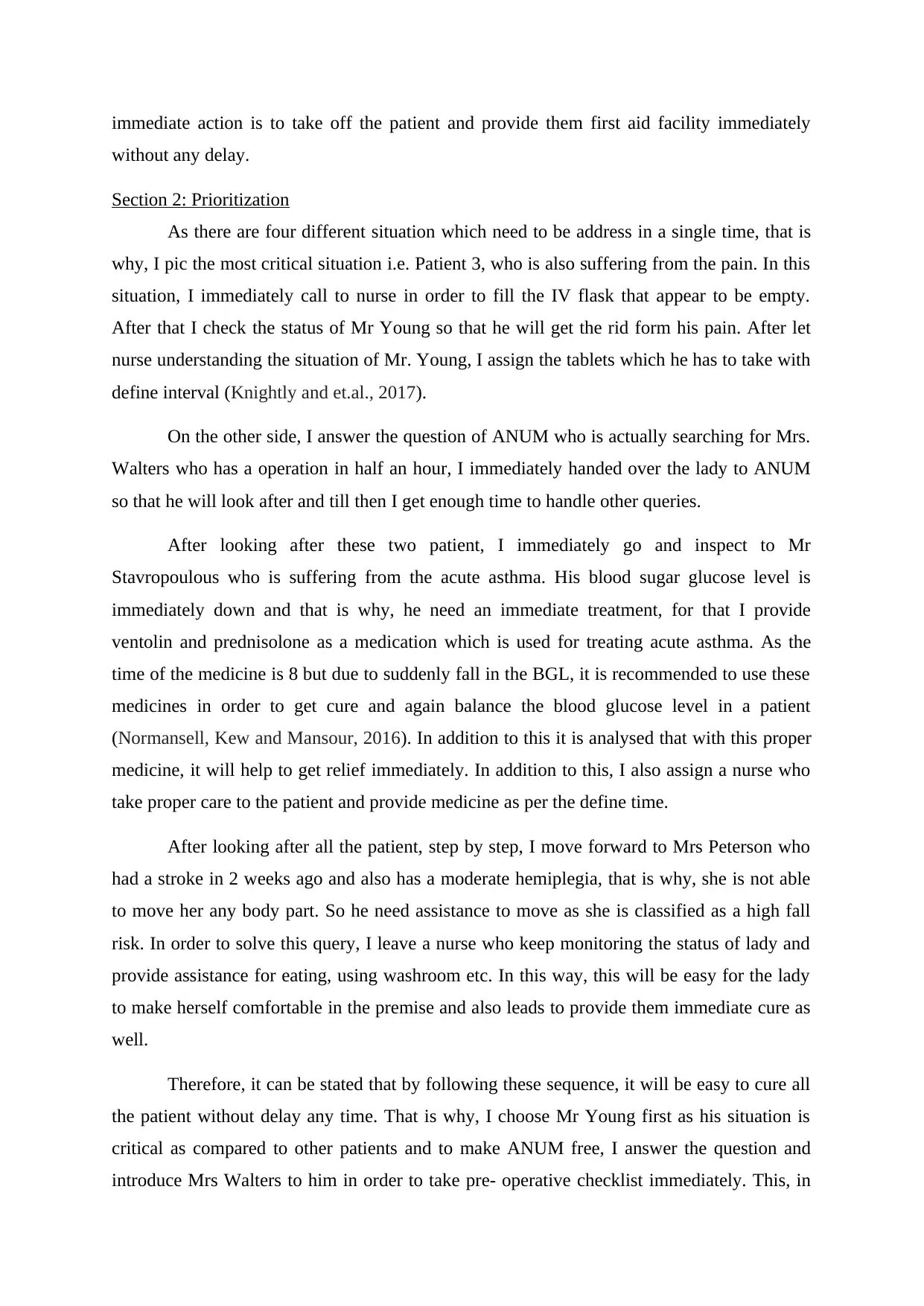
immediate action is to take off the patient and provide them first aid facility immediately
without any delay.
Section 2: Prioritization
As there are four different situation which need to be address in a single time, that is
why, I pic the most critical situation i.e. Patient 3, who is also suffering from the pain. In this
situation, I immediately call to nurse in order to fill the IV flask that appear to be empty.
After that I check the status of Mr Young so that he will get the rid form his pain. After let
nurse understanding the situation of Mr. Young, I assign the tablets which he has to take with
define interval (Knightly and et.al., 2017).
On the other side, I answer the question of ANUM who is actually searching for Mrs.
Walters who has a operation in half an hour, I immediately handed over the lady to ANUM
so that he will look after and till then I get enough time to handle other queries.
After looking after these two patient, I immediately go and inspect to Mr
Stavropoulous who is suffering from the acute asthma. His blood sugar glucose level is
immediately down and that is why, he need an immediate treatment, for that I provide
ventolin and prednisolone as a medication which is used for treating acute asthma. As the
time of the medicine is 8 but due to suddenly fall in the BGL, it is recommended to use these
medicines in order to get cure and again balance the blood glucose level in a patient
(Normansell, Kew and Mansour, 2016). In addition to this it is analysed that with this proper
medicine, it will help to get relief immediately. In addition to this, I also assign a nurse who
take proper care to the patient and provide medicine as per the define time.
After looking after all the patient, step by step, I move forward to Mrs Peterson who
had a stroke in 2 weeks ago and also has a moderate hemiplegia, that is why, she is not able
to move her any body part. So he need assistance to move as she is classified as a high fall
risk. In order to solve this query, I leave a nurse who keep monitoring the status of lady and
provide assistance for eating, using washroom etc. In this way, this will be easy for the lady
to make herself comfortable in the premise and also leads to provide them immediate cure as
well.
Therefore, it can be stated that by following these sequence, it will be easy to cure all
the patient without delay any time. That is why, I choose Mr Young first as his situation is
critical as compared to other patients and to make ANUM free, I answer the question and
introduce Mrs Walters to him in order to take pre- operative checklist immediately. This, in
without any delay.
Section 2: Prioritization
As there are four different situation which need to be address in a single time, that is
why, I pic the most critical situation i.e. Patient 3, who is also suffering from the pain. In this
situation, I immediately call to nurse in order to fill the IV flask that appear to be empty.
After that I check the status of Mr Young so that he will get the rid form his pain. After let
nurse understanding the situation of Mr. Young, I assign the tablets which he has to take with
define interval (Knightly and et.al., 2017).
On the other side, I answer the question of ANUM who is actually searching for Mrs.
Walters who has a operation in half an hour, I immediately handed over the lady to ANUM
so that he will look after and till then I get enough time to handle other queries.
After looking after these two patient, I immediately go and inspect to Mr
Stavropoulous who is suffering from the acute asthma. His blood sugar glucose level is
immediately down and that is why, he need an immediate treatment, for that I provide
ventolin and prednisolone as a medication which is used for treating acute asthma. As the
time of the medicine is 8 but due to suddenly fall in the BGL, it is recommended to use these
medicines in order to get cure and again balance the blood glucose level in a patient
(Normansell, Kew and Mansour, 2016). In addition to this it is analysed that with this proper
medicine, it will help to get relief immediately. In addition to this, I also assign a nurse who
take proper care to the patient and provide medicine as per the define time.
After looking after all the patient, step by step, I move forward to Mrs Peterson who
had a stroke in 2 weeks ago and also has a moderate hemiplegia, that is why, she is not able
to move her any body part. So he need assistance to move as she is classified as a high fall
risk. In order to solve this query, I leave a nurse who keep monitoring the status of lady and
provide assistance for eating, using washroom etc. In this way, this will be easy for the lady
to make herself comfortable in the premise and also leads to provide them immediate cure as
well.
Therefore, it can be stated that by following these sequence, it will be easy to cure all
the patient without delay any time. That is why, I choose Mr Young first as his situation is
critical as compared to other patients and to make ANUM free, I answer the question and
introduce Mrs Walters to him in order to take pre- operative checklist immediately. This, in
Paraphrase This Document
Need a fresh take? Get an instant paraphrase of this document with our AI Paraphraser
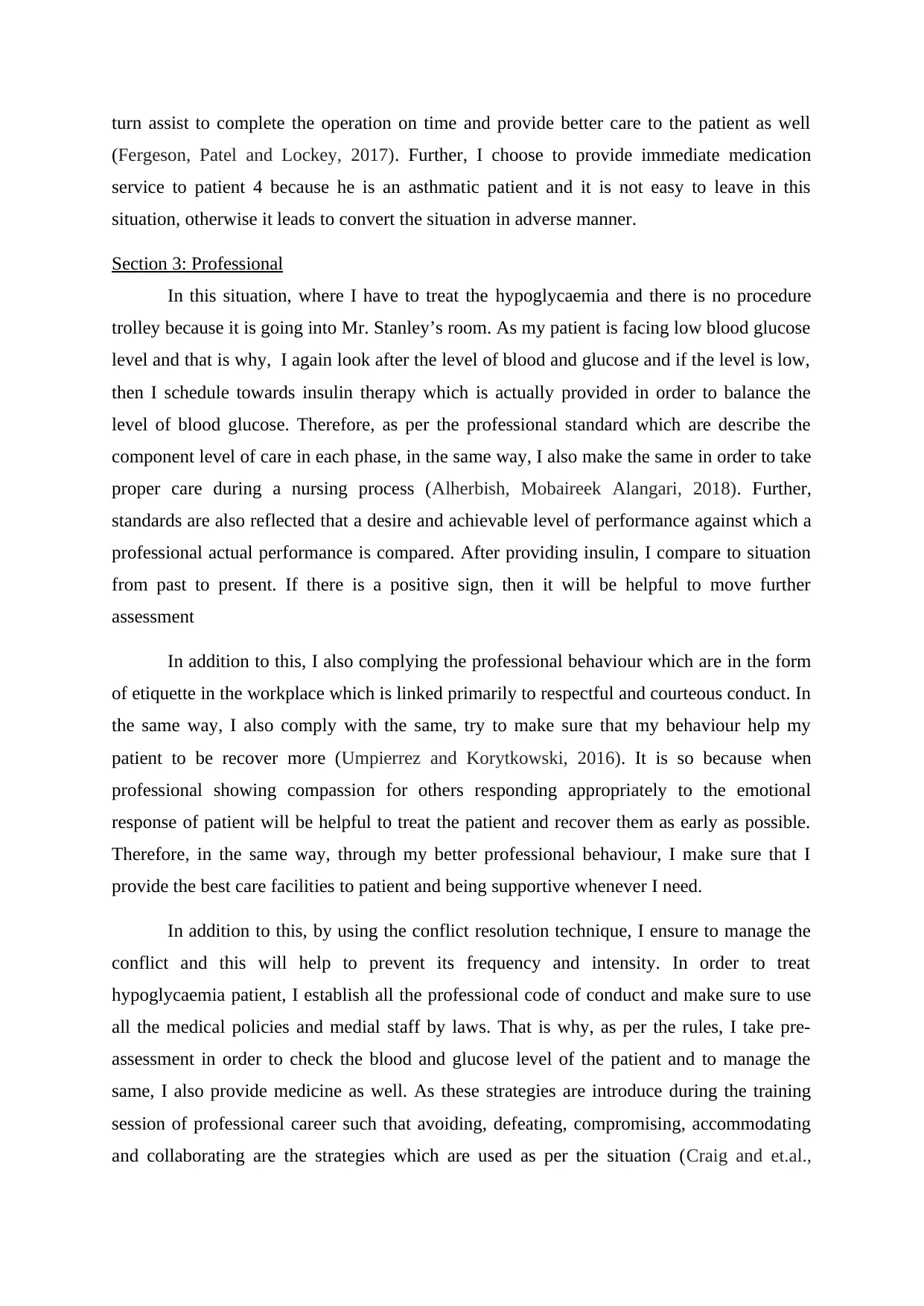
turn assist to complete the operation on time and provide better care to the patient as well
(Fergeson, Patel and Lockey, 2017). Further, I choose to provide immediate medication
service to patient 4 because he is an asthmatic patient and it is not easy to leave in this
situation, otherwise it leads to convert the situation in adverse manner.
Section 3: Professional
In this situation, where I have to treat the hypoglycaemia and there is no procedure
trolley because it is going into Mr. Stanley’s room. As my patient is facing low blood glucose
level and that is why, I again look after the level of blood and glucose and if the level is low,
then I schedule towards insulin therapy which is actually provided in order to balance the
level of blood glucose. Therefore, as per the professional standard which are describe the
component level of care in each phase, in the same way, I also make the same in order to take
proper care during a nursing process (Alherbish, Mobaireek Alangari, 2018). Further,
standards are also reflected that a desire and achievable level of performance against which a
professional actual performance is compared. After providing insulin, I compare to situation
from past to present. If there is a positive sign, then it will be helpful to move further
assessment
In addition to this, I also complying the professional behaviour which are in the form
of etiquette in the workplace which is linked primarily to respectful and courteous conduct. In
the same way, I also comply with the same, try to make sure that my behaviour help my
patient to be recover more (Umpierrez and Korytkowski, 2016). It is so because when
professional showing compassion for others responding appropriately to the emotional
response of patient will be helpful to treat the patient and recover them as early as possible.
Therefore, in the same way, through my better professional behaviour, I make sure that I
provide the best care facilities to patient and being supportive whenever I need.
In addition to this, by using the conflict resolution technique, I ensure to manage the
conflict and this will help to prevent its frequency and intensity. In order to treat
hypoglycaemia patient, I establish all the professional code of conduct and make sure to use
all the medical policies and medial staff by laws. That is why, as per the rules, I take pre-
assessment in order to check the blood and glucose level of the patient and to manage the
same, I also provide medicine as well. As these strategies are introduce during the training
session of professional career such that avoiding, defeating, compromising, accommodating
and collaborating are the strategies which are used as per the situation (Craig and et.al.,
(Fergeson, Patel and Lockey, 2017). Further, I choose to provide immediate medication
service to patient 4 because he is an asthmatic patient and it is not easy to leave in this
situation, otherwise it leads to convert the situation in adverse manner.
Section 3: Professional
In this situation, where I have to treat the hypoglycaemia and there is no procedure
trolley because it is going into Mr. Stanley’s room. As my patient is facing low blood glucose
level and that is why, I again look after the level of blood and glucose and if the level is low,
then I schedule towards insulin therapy which is actually provided in order to balance the
level of blood glucose. Therefore, as per the professional standard which are describe the
component level of care in each phase, in the same way, I also make the same in order to take
proper care during a nursing process (Alherbish, Mobaireek Alangari, 2018). Further,
standards are also reflected that a desire and achievable level of performance against which a
professional actual performance is compared. After providing insulin, I compare to situation
from past to present. If there is a positive sign, then it will be helpful to move further
assessment
In addition to this, I also complying the professional behaviour which are in the form
of etiquette in the workplace which is linked primarily to respectful and courteous conduct. In
the same way, I also comply with the same, try to make sure that my behaviour help my
patient to be recover more (Umpierrez and Korytkowski, 2016). It is so because when
professional showing compassion for others responding appropriately to the emotional
response of patient will be helpful to treat the patient and recover them as early as possible.
Therefore, in the same way, through my better professional behaviour, I make sure that I
provide the best care facilities to patient and being supportive whenever I need.
In addition to this, by using the conflict resolution technique, I ensure to manage the
conflict and this will help to prevent its frequency and intensity. In order to treat
hypoglycaemia patient, I establish all the professional code of conduct and make sure to use
all the medical policies and medial staff by laws. That is why, as per the rules, I take pre-
assessment in order to check the blood and glucose level of the patient and to manage the
same, I also provide medicine as well. As these strategies are introduce during the training
session of professional career such that avoiding, defeating, compromising, accommodating
and collaborating are the strategies which are used as per the situation (Craig and et.al.,

2017). During this situation, when RMO with the procedure trolley going into Mr Stanley’s
room, I am not able to provide proper care to the patient, at that time, I try to use avoiding as
a conflict resolution strategy which in turn assist to meet the define aim. Through this
strategy, I make sure that I use this method and try to avoid the conflict otherwise it affect the
overall workplace in negative manner. It is also stated that I start taking assessment from
initial stage in order to avoid any loopholes during treatment.
As per the professional requirement, it is stated that, it is the duty of the doctor to take
proper care of their patient and also provide them immediate cure or treatment without
affecting the results. In this stage, when a doctor have no availability of the staff, they have to
alone treat the patient and for that, education is used and at the last stage, make sure to take
feedback from RMO in order to determine the loopholes. As per the situation, it is analysed
that Mr. Stanley is having an ascetic tap and that is why, he need more cure as compared to
another patient (Cairns and Connell, 2018). Therefore, during monitoring the hypoglycaemic
patient, make sure that doctor is treat it promptly at all times, on the other side, proper
glucose table are also ask to taken in order to make the level of BGL balance. On the other
side, if these are not properly cure with specified deadline, then it may also leads to cause
death. That is why, if there is no availability of the staff, doctor have to take a risk and
provide proper treatment to them so that it will not cause any negative impact upon the
patient’s health and all the regulation, requirement are also met.
room, I am not able to provide proper care to the patient, at that time, I try to use avoiding as
a conflict resolution strategy which in turn assist to meet the define aim. Through this
strategy, I make sure that I use this method and try to avoid the conflict otherwise it affect the
overall workplace in negative manner. It is also stated that I start taking assessment from
initial stage in order to avoid any loopholes during treatment.
As per the professional requirement, it is stated that, it is the duty of the doctor to take
proper care of their patient and also provide them immediate cure or treatment without
affecting the results. In this stage, when a doctor have no availability of the staff, they have to
alone treat the patient and for that, education is used and at the last stage, make sure to take
feedback from RMO in order to determine the loopholes. As per the situation, it is analysed
that Mr. Stanley is having an ascetic tap and that is why, he need more cure as compared to
another patient (Cairns and Connell, 2018). Therefore, during monitoring the hypoglycaemic
patient, make sure that doctor is treat it promptly at all times, on the other side, proper
glucose table are also ask to taken in order to make the level of BGL balance. On the other
side, if these are not properly cure with specified deadline, then it may also leads to cause
death. That is why, if there is no availability of the staff, doctor have to take a risk and
provide proper treatment to them so that it will not cause any negative impact upon the
patient’s health and all the regulation, requirement are also met.
⊘ This is a preview!⊘
Do you want full access?
Subscribe today to unlock all pages.

Trusted by 1+ million students worldwide

REFERENCES
Books and Journals
Alherbish, M., Mobaireek, K. F., & Alangari, A. A. (2018). Admission predictability of
children with acute asthma. Annals of thoracic medicine. 13(1). 36.
Cairns, R., & Connell, L. (2018, November). Multiple acyl-CoA Dehydrogenase Deficiency:
a rare cause of hypoglycaemia. In Society for Endocrinology BES 2018 (Vol. 59).
BioScientifica.
Craig, C. M. and et.al., (2017). Critical role for GLP-1 in symptomatic post-bariatric
hypoglycaemia. Diabetologia, 60(3), 531-540.
Fergeson, J. E., Patel, S. S., & Lockey, R. F. (2017). Acute asthma, prognosis, and
treatment. Journal of Allergy and Clinical Immunology.139(2). 438-447.
Kinney, M. O., Kovac, S., & Diehl, B. (2019). Structured testing during seizures: A practical
guide for assessing and interpreting ictal and postictal signs during video EEG long
term monitoring. Seizure.
Knightly, R. and et.al., (2017). Inhaled magnesium sulfate in the treatment of acute
asthma. Cochrane Database of Systematic Reviews, (11).
Nishii, R. and et.al., (2018). FMZ-PET to assess the efficacy and the mechanism of ketogenic
diet in patients with intractable epilepsy. Imaging in Medicine. 10(1). 9-16.
Nogueira, A. B. and et.al., (2017). Hypothesis on the role of Cryptochromes in inflammation
and subarachnoid Hemorrhage outcome. Frontiers in neurology. 8. 637.
Normansell, R., Kew, K. M., & Mansour, G. (2016). Different oral corticosteroid regimens
for acute asthma. Cochrane Database of Systematic Reviews, (5).
Umpierrez, G., & Korytkowski, M. (2016). Diabetic emergencies—ketoacidosis,
hyperglycaemic hyperosmolar state and hypoglycaemia. Nature Reviews
Endocrinology, 12(4), 222.
Books and Journals
Alherbish, M., Mobaireek, K. F., & Alangari, A. A. (2018). Admission predictability of
children with acute asthma. Annals of thoracic medicine. 13(1). 36.
Cairns, R., & Connell, L. (2018, November). Multiple acyl-CoA Dehydrogenase Deficiency:
a rare cause of hypoglycaemia. In Society for Endocrinology BES 2018 (Vol. 59).
BioScientifica.
Craig, C. M. and et.al., (2017). Critical role for GLP-1 in symptomatic post-bariatric
hypoglycaemia. Diabetologia, 60(3), 531-540.
Fergeson, J. E., Patel, S. S., & Lockey, R. F. (2017). Acute asthma, prognosis, and
treatment. Journal of Allergy and Clinical Immunology.139(2). 438-447.
Kinney, M. O., Kovac, S., & Diehl, B. (2019). Structured testing during seizures: A practical
guide for assessing and interpreting ictal and postictal signs during video EEG long
term monitoring. Seizure.
Knightly, R. and et.al., (2017). Inhaled magnesium sulfate in the treatment of acute
asthma. Cochrane Database of Systematic Reviews, (11).
Nishii, R. and et.al., (2018). FMZ-PET to assess the efficacy and the mechanism of ketogenic
diet in patients with intractable epilepsy. Imaging in Medicine. 10(1). 9-16.
Nogueira, A. B. and et.al., (2017). Hypothesis on the role of Cryptochromes in inflammation
and subarachnoid Hemorrhage outcome. Frontiers in neurology. 8. 637.
Normansell, R., Kew, K. M., & Mansour, G. (2016). Different oral corticosteroid regimens
for acute asthma. Cochrane Database of Systematic Reviews, (5).
Umpierrez, G., & Korytkowski, M. (2016). Diabetic emergencies—ketoacidosis,
hyperglycaemic hyperosmolar state and hypoglycaemia. Nature Reviews
Endocrinology, 12(4), 222.
1 out of 7
Related Documents
Your All-in-One AI-Powered Toolkit for Academic Success.
+13062052269
info@desklib.com
Available 24*7 on WhatsApp / Email
![[object Object]](/_next/static/media/star-bottom.7253800d.svg)
Unlock your academic potential
Copyright © 2020–2025 A2Z Services. All Rights Reserved. Developed and managed by ZUCOL.





